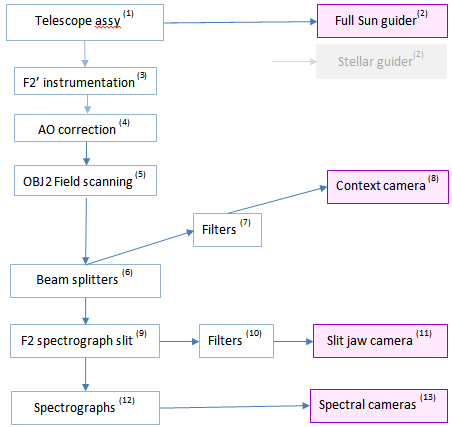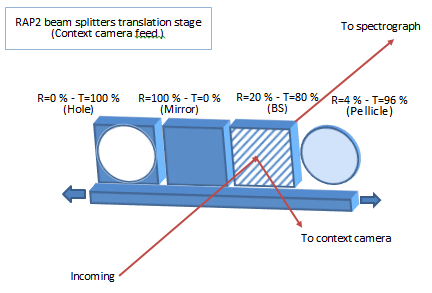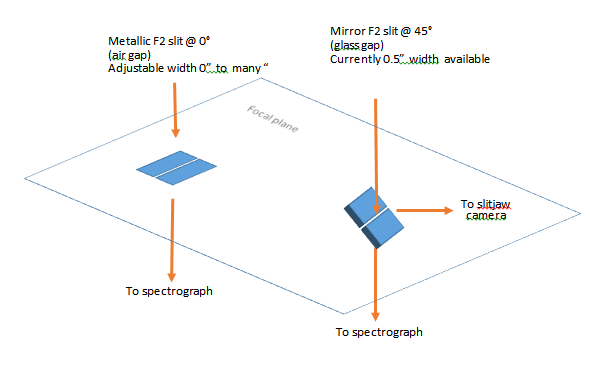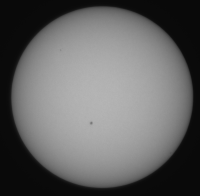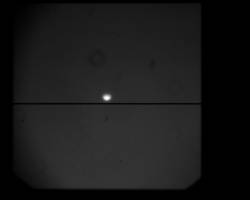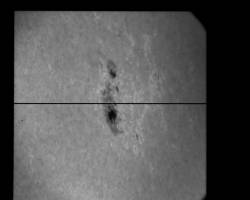Users information on instrumentation (2024 campaign)
Specific to 2024 campaign
- MTR2 in spectroscopy mode In this mode we propose up to 4 (old) EMCCD Andor iXon camera (512×512) and up to 2 (new) Andor Zyla (2kx2k) cameras. Both 6 cameras can be setup and used at the same time (with their respectives specs) , in accordance with the SP2 output limitations.
- MTR2 in spectropolarimetry mode
Please note: - Polarimetry will be available starting in spring 2024. After analyzing difficulties encountered in 2022, we have been calibrating the An4 analyzer in 2023. Calibration on telescope shall be completed in early 2024 and before the start of the campaign. The optical setup is also being reviewed, mostly for the output on the cameras much cleaner than before.
- You shall be aware that at that moment, THEMIS has no analysis software to properly compute Stokes maps (besides the basic “beam exchange substraction” feature). One difficulty is that there is not yet any polarimetric data available that we can use. Please note that any such software development is usually long, meaning that it is most unlikely that a complete quick-look shall be available at the beginning of 2024. The most basic step (subtraction of consecutive spectral images) is enough to tell that the correct component has been correctly observed, but do not expect much more..
- Broadband imaging camera, running concurrently with the spectrograph}. Nominal setup is for G-band, but this can be changed optionally (current setup is for 650 nm (red))
- Adaptive optics is available and tested over sunspots and granulation with good results.
A slowed-down (100Hz) version of the same system can be used to stabilize Mercury.
At the moment we have no information on using AO over the solar limb (or for neighbouring prominences).
Telescope and instrumentation technical information
This part being refreshed (2022 Nov)
THEMIS is a versatile solar/planetary telescope that can be used in daylight for solar or bright objects observations, or at night for fainter objects. Note that because of our limited manpower, night time programs are restricted to a few nights per year.
We handle the (extremely) wide range of available flux through a dedicated light distribution detailed below.
4 data products are currently available at the telescope:
- Full disk guider images
- Context camera (broad band imager)
- Slitjaw camera
- Spectral cameras (with or without polarimetry)
These products are listed on the functional diagram below, with some information of the light path leading to these items and the possible options available to the users
Below is a description of each of the functional blocks, with the available options (if any)
1. Telescope Assembly
The telescope optical path has been modified in 2018 to allow for the simplification of the transfer optics F1 → F2'. The secondary mirror has been refigured, together with a change of the exit window (now an exit lens with optical power and positive chromatic effects). The main resulting characterics are a new f/16.58 F1 (quite close to the former version), and a new position (lower on) for this focus. No user options available here.
2. Full Sun guider / stellar guider
- The historical full-sun guider still exists, but is now due to become a nightime guider (sometime). This guider works by inserting a small extra mirror in the light path above the M1 mirror, hence creates a dark indentation over the telescope pupil, wich cannot be allowed for solar AO operation (the pupil shall as free as possible of any obscuration). Motor EM19 is used to drive in or out this mirror and normal position for solar observation is now OUT.
- A new full-sun guider has been setup on the telescope outer ring of heat protection, near the 1m entrance plate. It uses a 45/500 mm objective, an Herschel prism, a neutral filter, a green continuum 540 nm photosphere filter, and a ZWO ASI 178 mono (2kx3k) CMOS camera. This image is always available in the control room. Please note that given the location of the entrance pupil and depending on the telescope/dome relative positions, this guider may be momentarily obscured by the dome edge(for less than 30 seconds in any circumstance). This is signaled on the guider monitor, and no premature conclusion shall be drawn if this image goes dark during a manual offset of the telescope. The image from this camera is an available data product (see below).
3. F2' instrumentation
4. Adaptive Optics correction
5. OBJ2 field scanning
6. Beam splitters
We currently have no unique solution for a feeding a context camera in all the possible situations of flux. This is why we setup a translation stage with the following beam-splitting options:
- Passthrough (100% transmitted, 0% reflected). This option is for planetary and stellar spectropolarimetry requesting 100% of the flux to the spectrograph. Obviously there is no light on the context camera, but there is light on the slitjaw camera with a mirror decker slit, providing a low quality image of the field,and showing the slit position.
- plain lambda/10 mirror (0% transmitted, 100% reflected).This option is suitable for pure imaging program of (preferably) faint objects. It is also an engineering mode for tuning the adaptive optics NCP abberations.
- Custom wideband beamsplitter (BS) (80% transmitted, 20% reflected over 400-1100 nm). This option allows the context camera to run in parallel with the spectrograph, providing a high quality field image together with the spectropolarimetric analysis. The ratio 20/80 is choosen because the 2nd surface coating of the BS plate shall provoke a (displaced) 2nd image in the range 0.5 to 1%, hence a ratio 20 to 40 with the first surface, requested to safely ignore this issue.
- Pellicle (96% transmitted, 4% reflected, wide band). This option is offered as a backup in the case the BS would not work properly; Pellicles have no 2nd image and a much larger transmitted fraction, the reflected 4% is largely enough to feed the context camera. However they have a poor optical quality and cannot be used for tuning the AO for NCP abberations.
We recommend the user to choose one configuration for the whole run, as for now the amount of refocusing and adjusting the flux on the camera after a change is not precisely known.
7. Beam splitters filters
Our 3 beamsplitting options are splitting on a wideband and with very different range of flux. A choice of broad band inteference filters and matching neutral densities to suit a particular request is available (list under construction).
8. Context camera
Context camera is currently a 2kx2k Andor Zyla (refs). Acqusition system and post-processing are available, specs TBW
9. F2 spectrograph slit
We currently offer 2 slit configuration:
- a mecanical adjustble slit
- a 45° mirror slit
The mechanical slit is the “historic” Themis slit (since 2004 at least), and is suitable for solar observation. If the context camera is used, then the fov image is available and this slit can be used, with the advantage that it is continuously adjustable to any width.
The 45° slit is primarily for faint objects observations that require 100% of the incoming light to be sent to the specrograph. In this case, the context camera is useless. This mirror decker diverts all the light that does not enter the spectrogaph to a side slitjaw camera. This camera can then provide the fov image, with the actual slit superimposed.
10. Slitjaw filters
11. Slitjaw camera
Currently a Pixelink PLA720 showing the full 2' field on a 1280×1024 max resolution specs TBW
12. Spectrographs
13. Spectral cameras
As of 2022, we offer:
- 6 EMCCD Andor iXon DV897 (iXon tech specs)
These are our first batch of moderm cameras, still very useful and mandatory for Mercury observations. A typical setup on these camera with a standard de-magnification will give a spectral pixel of ~ 0.0123 A/px (12.3 mA/px), and a spatial pixel of ~0.234 “/px; the full spectral range on the detector is about 6.3 A ,
- 2 sCMOS Andor Zyla 4.2 Plus (Zyla tech specs)
Our Zylas are interfaced and tested, both optomechanically and as to software, but they haven't been yet used for science at this moment. A typical setup shall give a spatial pixel of ~ 0.06” and a corresponding spectral pixel about 3mA/px, which may be preferable to rebin (by a factor of 2 at least) in the lambda direction.
Spectrograph cameras are at the “camera focii”, which differ from the spectrograph focus (“SP2” focus), because the focal scale of the latter is way too large for the spectral image to fit over modern detectors. The de-magnification comes with a turn in the geometry: the SP2 output is directed toward the ceiling of the spectrograph, but the cameras are on a horizontal beam. The optical assy performing this function is call “barette” (in french) and tuning the barettes is a part of the user's setup. Typical de-magnification assuming the complete spatial field is on the detector is: ~3.8 for an iXon camera and ~2.25 for a Zyla. These numbers hold in spectroscopic or spectropolarimetric mode, but for spectropolarimetry the spatial field is reduced (stopped at the F2) to make space on the detector for the dual beam polarimetric output.
Data products samples
- Full disk guider images
- Context camera (broad band imager)
Natural image without AO, with AO, with AO and post-facto reconstruction
- Slitjaw camera
Planetary configuration (Mercury) Solar configuration Field scanning example (with AO) Scan over Mercury (100Hz stabilization)
- Spectral cameras
NaD2 config with field scanning and AO

